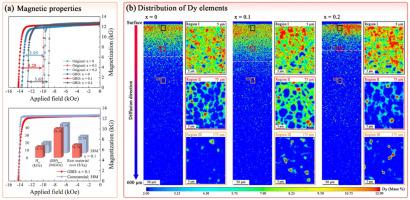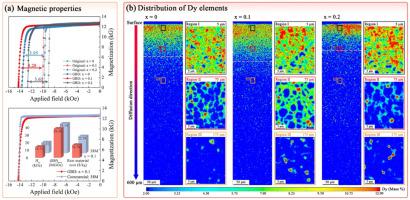克服铈基烧结磁体的晶界扩散挑战:La取代作为增强矫顽力的途径
IF 9.3
1区 材料科学
Q1 MATERIALS SCIENCE, MULTIDISCIPLINARY
引用次数: 0
摘要
本研究通过晶界扩散(GBD)技术解决了ce基烧结磁体的低扩散效率和最小矫顽力增强的挑战。通过对la取代ce基磁体进行全面的实验和理论分析,揭示了REFe2相对晶界结构和扩散过程的不利影响。我们的研究结果证实,最佳的La替代Ce有效地缓解了这些问题。这种取代降低了REFe2相的稳定性和Dy含量,增强了层状GB相的连续性。因此,在扩散过程中使用的Dy元素实现了更大的渗透深度和更均匀的分布,使得具有理想La含量的GBD磁体的矫顽力显著增加4.28 kOe,比无La磁体提高了8.35%。该研究揭示了其潜在的机制,并为增强ce基烧结磁体的GBD效应提供了可行的解决方案。此外,它强调了相稳定性,晶界结构和扩散动力学在下一代磁性材料GBD技术进步中的关键相互作用。本文章由计算机程序翻译,如有差异,请以英文原文为准。


Overcoming grain boundary diffusion challenges in Ce-based sintered magnets: La substitution as a pathway to enhanced coercivity
This study addresses the challenges of low diffusion efficiency and minimal coercivity enhancement in Ce-based sintered magnets through the grain boundary diffusion (GBD) technique. By conducting a comprehensive experimental and theoretical analysis of La-substituted Ce-based magnets, we have uncovered the detrimental impact of the REFe2 phase on grain boundary (GB) structure and the diffusion process. Our findings confirm that an optimal La substitution for Ce effectively mitigates these issues. This substitution reduces the stability and Dy content of the REFe2 phase while enhances the continuity of the lamellar GB phases. Consequently, the Dy element utilized in the diffusion process achieves a greater depth of penetration and a more uniform distribution, leading to a significant coercivity increase of 4.28 kOe in the GBD magnet with the ideal La content, an 8.35 % improvement over the La-free magnet. This research reveals the underlying mechanisms and offers a viable solution for enhancing the GBD effect in Ce-based sintered magnets. Furthermore, it underscores the pivotal interplay between phase stability, grain boundary structure, and diffusion dynamics in the advancement of next-generation GBD techniques for permanent magnets.
求助全文
通过发布文献求助,成功后即可免费获取论文全文。
去求助
来源期刊

Acta Materialia
工程技术-材料科学:综合
CiteScore
16.10
自引率
8.50%
发文量
801
审稿时长
53 days
期刊介绍:
Acta Materialia serves as a platform for publishing full-length, original papers and commissioned overviews that contribute to a profound understanding of the correlation between the processing, structure, and properties of inorganic materials. The journal seeks papers with high impact potential or those that significantly propel the field forward. The scope includes the atomic and molecular arrangements, chemical and electronic structures, and microstructure of materials, focusing on their mechanical or functional behavior across all length scales, including nanostructures.
 求助内容:
求助内容: 应助结果提醒方式:
应助结果提醒方式:


